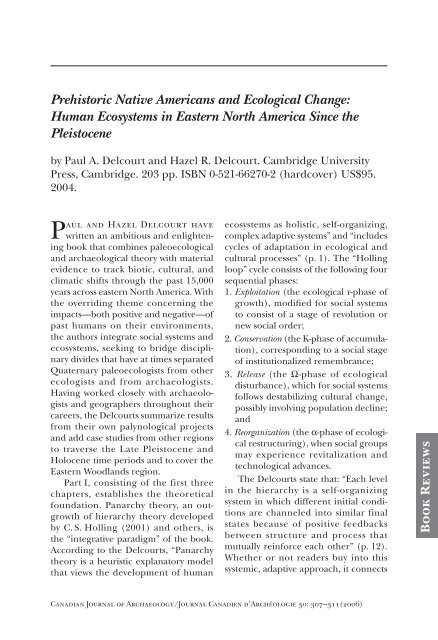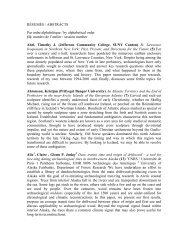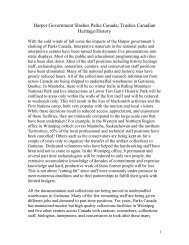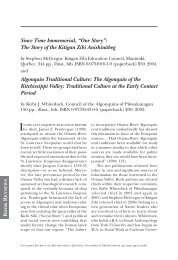Prehistoric Native Americans and Ecological Change - Canadian ...
Prehistoric Native Americans and Ecological Change - Canadian ...
Prehistoric Native Americans and Ecological Change - Canadian ...
You also want an ePaper? Increase the reach of your titles
YUMPU automatically turns print PDFs into web optimized ePapers that Google loves.
<strong>Prehistoric</strong> <strong>Native</strong> <strong>Americans</strong> <strong>and</strong> <strong>Ecological</strong> <strong>Change</strong>:Human Ecosystems in Eastern North America Since thePleistoceneby Paul A. Delcourt <strong>and</strong> Hazel R. Delcourt. Cambridge UniversityPress, Cambridge. 203 pp. ISBN 0-521-66270-2 (hardcover) US$95.2004.Paul <strong>and</strong> Hazel Delcourt havewritten an ambitious <strong>and</strong> enlighteningbook that combines paleoecological<strong>and</strong> archaeological theory with materialevidence to track biotic, cultural, <strong>and</strong>climatic shifts through the past 15,000years across eastern North America. Withthe overriding theme concerning theimpacts—both positive <strong>and</strong> negative—ofpast humans on their environments,the authors integrate social systems <strong>and</strong>ecosystems, seeking to bridge disciplinarydivides that have at times separatedQuaternary paleoecologists from otherecologists <strong>and</strong> from archaeologists.Having worked closely with archaeologists<strong>and</strong> geographers throughout theircareers, the Delcourts summarize resultsfrom their own palynological projects<strong>and</strong> add case studies from other regionsto traverse the Late Pleistocene <strong>and</strong>Holocene time periods <strong>and</strong> to cover theEastern Woodl<strong>and</strong>s region.Part I, consisting of the first threechapters, establishes the theoreticalfoundation. Panarchy theory, an outgrowthof hierarchy theory developedby C. S. Holling (2001) <strong>and</strong> others, isthe “integrative paradigm” of the book.According to the Delcourts, “Panarchytheory is a heuristic explanatory modelthat views the development of humanecosystems as holistic, self-organizing,complex adaptive systems” <strong>and</strong> “includescycles of adaptation in ecological <strong>and</strong>cultural processes” (p. 1). The “Hollingloop” cycle consists of the following foursequential phases:1. Exploitation (the ecological r-phase ofgrowth), modified for social systemsto consist of a stage of revolution ornew social order;2. Conservation (the K-phase of accumulation),corresponding to a social stageof institutionalized remembrance;3. Release (the Ω-phase of ecologicaldisturbance), which for social systemsfollows destabilizing cultural change,possibly involving population decline;<strong>and</strong>4. Reorganization (the a-phase of ecologicalrestructuring), when social groupsmay experience revitalization <strong>and</strong>technological advances.The Delcourts state that: “Each levelin the hierarchy is a self-organizingsystem in which different initial conditionsare channeled into similar finalstates because of positive feedbacksbetween structure <strong>and</strong> process thatmutually reinforce each other” (p. 12).Whether or not readers buy into thissystemic, adaptive approach, it connectsBook Reviews<strong>Canadian</strong> Journal of Archaeology/Journal Canadien d’Archéologie 30: 307–311(2006)
308 • Fritzthe remaining substance of the book asthe authors lead us through time <strong>and</strong>across space.Part II (Chapters 4–8) begins withan overview of different spatial <strong>and</strong> temporalscales by which human-environmentalinteractions can be measured.Chapters progress from gene-level topopulation-level interactions <strong>and</strong> on tocommunity-, l<strong>and</strong>scape-, <strong>and</strong> regionallevelecosystem dynamics. The discussionof gene-level interactions (Chapter 4)focuses on indigenous plant domestication<strong>and</strong> later adoption of non-nativecultigens: maize <strong>and</strong> beans. During thetransition from foraging to farming thatbegan approximately 4500 years ago,within-species biological diversity wasenhanced.The chapter on population-levelinteractions (Chapter 5) begins witha look back to b<strong>and</strong>s of Paleoindianhunters <strong>and</strong> then turns to the morediversified Dalton foragers of the Pleistocene-Holoceneboundary in the centralMississippi Valley. In spite of abundantevidence for wood-working tools <strong>and</strong>higher population levels than before,these residentially mobile b<strong>and</strong>s arejudged “too dispersed in their seasonalround of hunting <strong>and</strong> foraging to haveplayed a substantive ecological role asa keystone species” (p. 63). With subsequentclimatic shifts that took placeduring early <strong>and</strong> middle Archaic times(11,500–6800 BP), mast-bearing treeswere more abundant than before acrossmuch of eastern North America, <strong>and</strong>archaeobotanical assemblages showintensified nut harvesting. This probablymarks the beginning of forest managementto enhance nut productivity<strong>and</strong> minimize competition from otheranimals. Domestication of plants suchas chenopod <strong>and</strong> sumpweed mighthave developed within the more open,grove-like patches as well as in or nearlonger-term base camps in both rivervalleys <strong>and</strong> associated upl<strong>and</strong> zones. Thisis presented as a positive impact thatincreased resource abundance in spite of“incipient forest fragmentation” (p. 71).Use of anthropogenic fire is not a topicof discussion up to this point.Chapters on interactions at thecommunity <strong>and</strong> l<strong>and</strong>scape level areconcerned with increasingly complexfood producers of Terminal Archaic,Woodl<strong>and</strong>, <strong>and</strong> Mississippian times(post-4500 BP), <strong>and</strong> this is wheremuch of the Delcourts’ own researchis featured. The Cliff Palace Pond,Kentucky, case study involves palynology<strong>and</strong> charcoal influx measurementscollected on a plateau ridge close to aseries of rockshelters exhibiting humanoccupation between 9000 <strong>and</strong> 1000 BP.Combined lines of evidence showalteration of forest composition by firebeginning at 3200 BP, the TerminalLate Archaic time frame when producersof Eastern Agricultural Complexcrops began to store <strong>and</strong> process theirseed stock <strong>and</strong> wild foods in caves <strong>and</strong>rockshelters across central <strong>and</strong> easternKentucky. Intentional burning is seenas the primary cause of major change:“The result of anthropogenic fire wasa fine-grained patchwork of vegetationon upper hillslopes <strong>and</strong> ridgetops thatincluded prehistoric garden plots, openpatches with mixed crops of domesticatedspecies, ab<strong>and</strong>oned Indianold-fields reverting back into early-successionalgrassl<strong>and</strong> barrens, thickets ofshrubs, <strong>and</strong> even-aged st<strong>and</strong>s of pitchpine or tulip poplar trees” (p. 85). Distinct<strong>and</strong> profound as these changeswere, the Delcourts consider this disturbanceregime as being on an intermediatelevel, with the overall effect ofenhancing heterogeneity.<strong>Canadian</strong> Journal of Archaeology 30 (2006)
<strong>Prehistoric</strong> <strong>Native</strong> <strong>Americans</strong> <strong>and</strong> <strong>Ecological</strong> <strong>Change</strong> • 309In Chapter 7, the scale shifts to thel<strong>and</strong>scape level, the time to 1000 BP<strong>and</strong> later, <strong>and</strong> degree of cultural complexityto fully agricultural Iroquoiansof Ontario <strong>and</strong> Mississippian chiefdoms.<strong>Canadian</strong> archaeologists will beespecially interested in the discussionof evidence for human-caused changesat Crawford Lake in southern Ontario.The authors combine archaeologicalevidence with pollen <strong>and</strong> charcoalfrom sediment cores to chronologicallycorrelate forest clearance <strong>and</strong> ashift from beech-maple to oak-pinecommunities with the occupation ofIroquoian villages. Climate change(the Little Ice Age) is considered asa cause contributing to the formationof white pine groves observed by earlyEuropeans in this area, but the Delcourtsfavour swidden agriculture asthe likely agent by which disturbanceintervals were shortened below therecovery threshold needed by maturehardwood forests.The Little Tennessee Valley is, likeCliff Palace Pond in Kentucky, a regionwhere the Delcourts were team membersin long-term research projects. With 74radiocarbon dates <strong>and</strong> 52 archaeomagneticdates available from the archaeologicalexcavations (along with a fewdates from pollen cores), this regionalcase study gives another long-term viewof environmental <strong>and</strong> cultural changes.In the Delcourts’ words, it “documentsthe evolution of a self-organized, panarchicalhuman ecosystem through theHolocene interglacial” (p. 108). Pollenspectra show increasing percentages ofpine (until 850 BP) <strong>and</strong> pioneer annualson terraces near villages as farming activitieswere intensified. Archaeobotanicalassemblages provide evidence for nativeseed crops, maize, <strong>and</strong> associated gardenweeds, along with higher frequencies ofwood charcoal representing disturbancerelatedtaxa. With population density onthe most favorable stretches of alluvialbottoml<strong>and</strong> growing to an estimated 52to 56 persons per km 2 , forest fragmentationexceeded “the threshold for habitatcontinuity of native bottoml<strong>and</strong> forestcommunities” (p. 109), pushing thel<strong>and</strong>scape into a state of disequilibriumby 800–1000 BP, with negative impactsincluding over-harvesting of deer <strong>and</strong>“denuded hill slopes” that amplifiedthe severity of floods. This now-classiccase study, the results of which werepublished in the 1980s (Chapman et al.1982; Delcourt 1987), opened the eyesof many scholars to potential impactsof Woodl<strong>and</strong> <strong>and</strong> Mississippian periodfood producers in the Southeast. Thesummary in this volume, though, mightbe too concise to do it justice. In particular,I missed any discussion of the pollenspectrum from Black Pond, located inan upl<strong>and</strong> setting 4 km from bottoml<strong>and</strong>sites, described by Hazel Delcourt(1987) as exhibiting little evidence ofdisturbance.Chapter 7 concludes with a discussionof “panarchical collapse” at Cahokiain the American Bottom of west-centralIllinois. To blame were high populationdensity (an estimate of 4,000 people inthe 10 km 2 core of downtown CahokiaMounds), clearance of all suitablefarml<strong>and</strong> in the floodplain for maizeagriculture, <strong>and</strong> deforestation of bothbottoml<strong>and</strong>s <strong>and</strong> upl<strong>and</strong>s for constructionpurposes. The authors incorporategeomorphological <strong>and</strong> climatic data,as they do throughout the book, citingevidence for more frequent <strong>and</strong> moreintense flooding in the Upper MississippiValley at approximately the sametime that Cahokia was ab<strong>and</strong>oned:“The denuded floodplain <strong>and</strong> upl<strong>and</strong>hillslopes set the stage for devastationJournal Canadien d’Archéologie 30 (2006)
310 • Fritzduring the series of catastrophic 500-yearfloods that occurred from 650 to 400 BP.Thus climatic, geologic, ecological, <strong>and</strong>anthropogenic interactions were all factorsthat forced the ab<strong>and</strong>onment ofCahokia” (pp. 128–129). Although theDelcourts present a reasonable pictureof social complexity <strong>and</strong> demography,the degree to which they stress environmentaldamage seems extreme, sincemost archaeologists look to a combinationof social <strong>and</strong> ecological causes.Milner (2004: 167–168), for example,invokes “enfeebled leadership,” statingthat: “Even in the best of circumstances,chiefs inevitably experienced reversals ofone kind or another that they were powerlessto stop. Their positions were surelytested during times of repeated shortages,especially if coupled with losses atthe h<strong>and</strong>s of their enemies.” A demographicvacuum persisted across theAmerican Bottom long after Cahokia’spopulation had declined, allowing timefor trees to grow back <strong>and</strong> soil fertilityto be replenished. Geographic shifts ofchiefdoms in eastern North Americaclearly had both social <strong>and</strong> environmentalexplanations.Chapter 8 moves out in scale toregional-level interactions but back intime to the late Pleistocene, taking onthe controversial issue of megafaunalextinctions. The authors implicatehumans, not as participants in a blitzkriegon unwary megafauna, but ashunters who displaced former keystonepredators at a time of severe stress due torapidly changing climate <strong>and</strong> vegetation.An unexpected twist is the Delcourts’positive view of the proposal by DennisStanford <strong>and</strong> Bruce Bradley that theroots of Clovis technology came acrossthe North Atlantic with descendants ofSolutreans. I am concerned that nonarchaeologistswho read this book willbe unaware of the skepticism with whichthis scenario is viewed in the professionalliterature. Nevertheless, it is noteworthythat scientists of the Delcourts’ calibreseem to favour European ancestryfor early occupants of eastern NorthAmerica.The final chapter, “The ecologicallegacy of prehistoric <strong>Native</strong> <strong>Americans</strong>,”discusses the strengths <strong>and</strong> limitations oftraditional ecological knowledge <strong>and</strong> theimplications that paleoecological studieshave for current forest managementpolicy. It ends with five conclusions:1. That humans “have been part of theNorth American ecological setting”since their arrival;2. That human ecosystems are panarchical<strong>and</strong> adaptive, with limits to sustainableresource use;3. That <strong>Native</strong> North <strong>Americans</strong> madeenvironmental impacts that hadconsequences throughout late Pleistocene<strong>and</strong> Holocene times;4. That there is “no such thing as aHolocene, ‘presettlement,’ naturalenvironment untouched by humanh<strong>and</strong>s in North America;” <strong>and</strong>5. That in addition to historical documents<strong>and</strong> traditional knowledge,integrated paleoecological <strong>and</strong>archaeological data “make it possibleto reconstruct the direct influences ofprehistoric humans on their ecologicalsetting.”A wealth of information is packedinto this small book, <strong>and</strong> it should beessential reading even for scholarsskeptical of the panarchical perspective,those who may think the impactof early <strong>and</strong> mid-Holocene burningis overlooked, or those who believethe Delcourts exaggerate the negativeeffects of late pre-Columbian agriculturalsocieties. The writing is clear <strong>and</strong>engaging, <strong>and</strong> the figures summarize<strong>Canadian</strong> Journal of Archaeology 30 (2006)
<strong>Prehistoric</strong> <strong>Native</strong> <strong>Americans</strong> <strong>and</strong> <strong>Ecological</strong> <strong>Change</strong> • 311complex data ingeniously. Except forthe shocking price, the book is appropriatefor upper division <strong>and</strong> graduatelevel courses in the several disciplinesintegrated so well by the work of Paul<strong>and</strong> Hazel Delcourt.REFERENCES CITEDChapman, J., P. A. Delcourt,P. A. Cridlebaugh, A. B. Shea, <strong>and</strong>H. R. Delcourt1982 Man-L<strong>and</strong> Interaction:10,000 years of American IndianImpact on <strong>Native</strong> Ecosystems in theLower Little Tennessee River Valley,Eastern Tennessee. Southeastern Archaeology1: 115–121.Delcourt, H. R.1987 The Impact of <strong>Prehistoric</strong> Agriculture<strong>and</strong> L<strong>and</strong> Occupation onNatural Vegetation. Trends in Ecology<strong>and</strong> Evolution 2: 39–44.Holling, C. S.2001 Underst<strong>and</strong>ing the Complexityof Economic, <strong>Ecological</strong>, <strong>and</strong> SocialSystems. Ecosystems 4: 390–405.Milner, G. R.2004 The Moundbuilders: Ancient Peoplesof Eastern North America. Thames<strong>and</strong> Hudson, London.Gayle J. FritzDepartment of AnthropologyWashington University in St. LouisJournal Canadien d’Archéologie 30 (2006)








